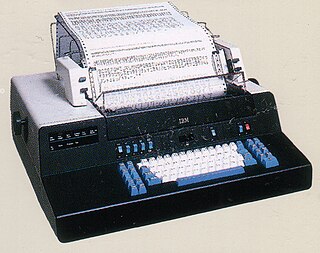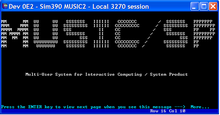
The IBM 3270 is a family of block oriented display and printer computer terminals introduced by IBM in 1971 and normally used to communicate with IBM mainframes. The 3270 was the successor to the IBM 2260 display terminal. Due to the text color on the original models, these terminals are informally known as green screen terminals. Unlike a character-oriented terminal, the 3270 minimizes the number of I/O interrupts required by transferring large blocks of data known as data streams, and uses a high speed proprietary communications interface, using coaxial cable.
Systems Network Architecture (SNA) is IBM's proprietary networking architecture, created in 1974. It is a complete protocol stack for interconnecting computers and their resources. SNA describes formats and protocols but, in itself, is not a piece of software. The implementation of SNA takes the form of various communications packages, most notably Virtual Telecommunications Access Method (VTAM), the mainframe software package for SNA communications.

The IBM Series/1 is a 16-bit minicomputer, introduced in 1976, that in many respects competed with other minicomputers of the time, such as the PDP-11 from Digital Equipment Corporation and similar offerings from Data General and HP. The Series/1 was typically used to control and operate external electro-mechanical components while also allowing for primitive data storage and handling.

A computer terminal is an electronic or electromechanical hardware device that can be used for entering data into, and transcribing data from, a computer or a computing system. Most early computers only had a front panel to input or display bits and had to be connected to a terminal to print or input text through a keyboard. Teleprinters were used as early-day hard-copy terminals and predated the use of a computer screen by decades. The computer would typically transmit a line of data which would be printed on paper, and accept a line of data from a keyboard over a serial or other interface. Starting in the mid-1970s with microcomputers such as the Sphere 1, Sol-20, and Apple I, display circuitry and keyboards began to be integrated into personal and workstation computer systems, with the computer handling character generation and outputting to a CRT display such as a computer monitor or, sometimes, a consumer TV, but most larger computers continued to require terminals.
Systems Application Architecture (SAA), introduced in 1987, is a set of standards for computer software developed by IBM. The SAA initiative was started in 1987 under the leadership of Earl Wheeler, the "Father of SAA". The intent was to implement SAA in IBM operating systems including MVS, OS/400 and OS/2. AIX—IBM's version of the UNIX operating system—was not a target of SAA, but does have interoperability with the SAA family.

IBM 5250 is a family of block-oriented terminals originally introduced with the IBM System/34 midrange computer systems in 1977. It also connects to the later System/36, System/38, and IBM AS/400 systems, and to IBM Power Systems systems running IBM i, as well as the Series/1 minicomputer.
Virtual Telecommunications Access Method (VTAM) is the IBM subsystem that implements Systems Network Architecture (SNA) for mainframe environments. VTAM provides an application programming interface (API) for communication applications, and controls communication equipment such as adapters and controllers. In modern terminology, VTAM provides a communication stack and device drivers.
Attachmate Corporation is a 1982-founded software company which focused on secure terminal emulation, legacy integration, and managed file transfer software. Citrix-compatibility and Attachment Reflection were enhanced/added offerings.

The IBM 3790 Communications System was one of the first distributed computing platforms. The 3790 was developed by IBM's Data Processing Division (DPD) and announced in 1974. It preceded the IBM 8100, announced in 1979.
Remote job entry, or Remote Batch, is the procedure for sending requests for non-interactive data processing tasks (jobs) to mainframe computers from remote workstations, and by extension the process of receiving the output from such jobs at a remote workstation.

Uniscope was a class of computer terminals made by Sperry Rand Corporation, Univac Division, and successors since 1964 that were normally used to communicate with Univac mainframes. As such, it was the successor to various models of Teletype. Due to the text color on the original models, these terminals are informally known as green screen terminals.

Irma board, originally spelled IRMA board, refers to a brand of coaxial interface cards for PCs and Macintosh computers used to enable 3270 emulator programs to connect to IBM mainframe computers. IRMA boards were used to connect PCs and Macs to IBM 3274 terminal controllers.

The IBM 3705 Communications Controller is a simple computer which attaches to an IBM System/360 or System/370. Its purpose is to connect communication lines to the mainframe channel. It was a first communications controller of the popular IBM 37xx series. It was announced in March 1972. Designed for semiconductor memory which was not ready at the time of announcement, the 3705-I had to use 1.2 microsecond core storage; the later 3705-II uses 1.0 microsecond SRAM. Solid Logic Technology components, similar to those in S/370, were used.

Teleprocessing Network Simulator (TPNS) is an IBM licensed program, first released in 1976 as a test automation tool to simulate the end-user activity of network terminal(s) to a mainframe computer system, for functional testing, regression testing, system testing, capacity management, benchmarking and stress testing.

The IBM 3270 PC, is a personal computer developed by IBM and released in October 1983. Although its hardware is mostly identical to the IBM PC XT, the 3270 contains additional components that, in combination with software, can emulate the behavior of an IBM 3270 terminal. Therefore, it can be used both as a standalone computer, and as a terminal to a mainframe.
The IBM Network Control Program, or NCP, was software that ran on a 37xx communications controller and managed communication with remote devices. NCP provided services comparable to the data link layer and Network Layer functions in the OSI model of a Wide area network.

The IBM 3745 is the latest and last of a 37xx family of communications controllers for the IBM mainframe environment. As of mid-2009 there were an estimated 7,000+ of the larger 3745 models still in active production status, down from 20,000 or more in 2007. The 3745 and associated 3746 models were once heavily used within financial, insurance and retail industries as well as within government agencies globally. However, today most organizations have migrated away from the use of 3745s. IBM's Enterprise Extender and the Communication Controller for Linux on System z (CCL) have largely displaced the older 3745s. IBM announced in September 2002 that it would no longer manufacture new 3745s, but IBM continues to support the hardware by providing worldwide maintenance service, by providing microcode releases and by supporting the associated software including NCP and the virtual telecommunications access method (VTAM). IBM has announced end-of-service dates for Japan, Europe and the Middle East, but has not yet announced end-of-service for the Americas and parts of Asia.
Microsoft Host Integration Server is a gateway application providing connectivity between Microsoft Windows networks and IBM mainframe and IBM i systems. Support is provided for SNA, 3270, 5250, CICS, APPC, and other IBM protocols. Support is also provided for advanced integration with Windows networks and software, such as linking Microsoft Message Queuing applications to IBM WebSphere MQ, binding Microsoft DTC transactions with CICS, and cross-protocol access to Db2 databases on IBM platforms.

IBM 3767 Communication Terminal is a serial printer terminal that employed dot matrix print-head technology and, for the first time, the Synchronous Data Link Control (SDLC) communications protocol set under IBM's Systems Network Architecture (SNA). It was introduced in 1974 and was used widely during the late 1970s to 1990s, for attachment to IBM System/360 and System/370 mainframe computers and IBM System/7 as an alternative to a 2741 typewriter terminal.

The IBM Personal Computer XT is the second computer in the IBM Personal Computer line, released on March 8, 1983. Except for the addition of a built-in hard drive and extra expansion slots, it is very similar to the original IBM PC model 5150 from 1981.













